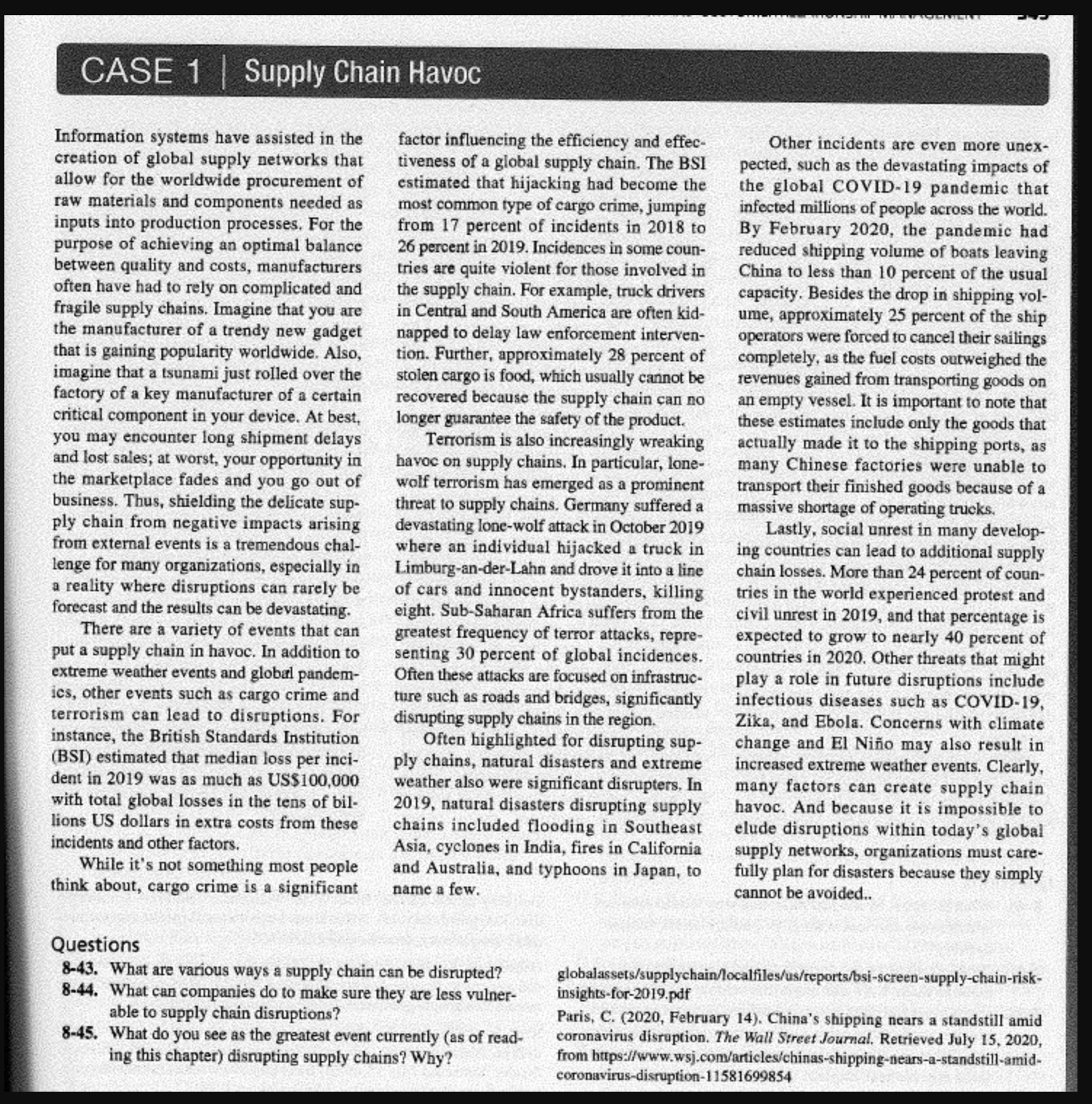Answered step by step
Verified Expert Solution
Question
1 Approved Answer
Case study given below read it and answer the following questions CASE 1 Supply Chain Havoc Information systems have assisted in the creation of global
Case study given below read it and answer the following questions

CASE 1 Supply Chain Havoc Information systems have assisted in the creation of global supply networks that allow for the worldwide procurement of raw materials and components needed as inputs into production processes. For the purpose of achieving an optimal balance between quality and costs, manufacturers often have had to rely on complicated and fragile supply chains. Imagine that you are the manufacturer of a trendy new gadget that is gaining popularity worldwide. Also, imagine that a tsunami just rolled over the factory of a key manufacturer of a certain critical component in your device. At best, you may encounter long shipment delays and lost sales; at worst, your opportunity in the marketplace fades and you go out of business. Thus, shielding the delicate sup- ply chain from negative impacts arising from external events is a tremendous chal- lenge for many organizations, especially in a reality where disruptions can rarely be forecast and the results can be devastating. There are a variety of events that can put a supply chain in havoc. In addition to extreme weather events and global pandem- ics, other events such as cargo crime and terrorism can lead to disruptions. For instance, the British Standards Institution (BSI) estimated that median loss per inci- dent in 2019 was as much as US$100,000 with total global losses in the tens of bil- lions US dollars in extra costs from these incidents and other factors. While it's not something most people think about, cargo crime is a significant factor influencing the efficiency and effec- tiveness of a global supply chain. The BSI estimated that hijacking had become the most common type of cargo crime, jumping from 17 percent of incidents in 2018 to 26 percent in 2019. Incidences in some coun- tries are quite violent for those involved in the supply chain. For example, truck drivers in Central and South America are often kid- napped to delay law enforcement interven- tion. Further, approximately 28 percent of stolen cargo is food, which usually cannot be recovered because the supply chain can no longer guarantee the safety of the product. Terrorism is also increasingly wreaking havoc on supply chains. In particular, lone- wolf terrorism has emerged as a prominent threat to supply chains. Germany suffered a devastating lone-wolf attack in October 2019 where an individual hijacked a truck in Limburg-an-der-Lahn and drove it into a line of cars and innocent bystanders, killing eight. Sub-Saharan Africa suffers from the greatest frequency of terror attacks, repre- senting 30 percent of global incidences. Often these attacks are focused on infrastruc- ture such as roads and bridges, significantly disrupting supply chains in the region. Often highlighted for disrupting sup- ply chains, natural disasters and extreme weather also were significant disrupters. In 2019, natural disasters disrupting supply chains included flooding in Southeast Asia, cyclones in India, fires in California and Australia, and typhoons in Japan, to name a few. Questions 8-43. What are various ways a supply chain can be disrupted? 8-44. What can companies do to make sure they are less vulner- able to supply chain disruptions? 8-45. What do you see as the greatest event currently (as of read- ing this chapter) disrupting supply chains? Why? Other incidents are even more unex- pected, such as the devastating impacts of the global COVID-19 pandemic that infected millions of people across the world. By February 2020, the pandemic had reduced shipping volume of boats leaving China to less than 10 percent of the usual capacity. Besides the drop in shipping vol- ume, approximately 25 percent of the ship operators were forced to cancel their sailings completely, as the fuel costs outweighed the revenues gained from transporting goods on an empty vessel. It is important to note that these estimates include only the goods that actually made it to the shipping ports, as many Chinese factories were unable to transport their finished goods because of a massive shortage of operating trucks. Lastly, social unrest in many develop- ing countries can lead to additional supply chain losses. More than 24 percent of coun- tries in the world experienced protest and civil unrest in 2019, and that percentage is expected to grow to nearly 40 percent of countries in 2020. Other threats that might play a role in future disruptions include infectious diseases such as COVID-19, Zika, and Ebola. Concerns with climate change and El Nio may also result in increased extreme weather events. Clearly, many factors can create supply chain havoc. And because it is impossible to elude disruptions within today's global supply networks, organizations must care- fully plan for disasters because they simply cannot be avoided.. globalassets/supplychain/localfiles/us/reports/bsi-screen-supply-chain-risk- insights-for-2019.pdf Paris, C. (2020, February 14). China's shipping nears a standstill amid coronavirus disruption. The Wall Street Journal. Retrieved July 15, 2020, from https://www.wsj.com/articles/chinas-shipping-nears-a-standstill-amid- coronavirus-disruption-11581699854
Step by Step Solution
There are 3 Steps involved in it
Step: 1
To make companies less vulnerable to supply chain disruptions several strategies can be implemented 1 Diversification of Suppliers Relying on multiple ...
Get Instant Access to Expert-Tailored Solutions
See step-by-step solutions with expert insights and AI powered tools for academic success
Step: 2

Step: 3

Ace Your Homework with AI
Get the answers you need in no time with our AI-driven, step-by-step assistance
Get Started


